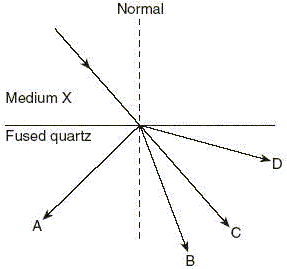2. In a vacuum, all electromagnetic waves have the same (1) wavelength; (2) frequency; (3) speed; (4) amplitude
3. The speed of light (f =5.09 x 1014 Hz) in a transparent material is 0.75 times its speed in air. The absolute index of refraction of the material is approximately:____
4. A sound of constant frequency is produced by the siren on top of a firehouse. Compared to the frequency produced by the siren, the frequency observed by a firefighter approaching the firehouse is (1) lower; (2) higher; (3) the same.
5. The diagram (Fig.1.) represents a ray of monochromatic light (f =5.09 x 1014 Hz) passing from medium X (n = 1.46) into fused quartz. Which path will the ray follow in the quartz? (Index of refraction of fused quartz: at 587.6 nm: 1.4585) (1) A; (2) B; (3) C; (4) D.
6. A wave is transporting energy from left to right. The particles of the medium are moving back and forth in a leftward and rightward direction. This type of wave is known as a: (a) surface; (b) electromagnetic; (c) transverse; (d) longitudinal.
7. Circle the type of mechanical wave that can exist in the medium indicated. Note that in some media both types exist: (T) Transverse, (L) Longitudinal. (O, Only together) Waves can not have properties of only one wave type: or longitudinal, or transverse. (N) Mechanical waves don’t exist
 Fig.1.
Fig.1.
 Fig.2.
Fig.2.
 (Fig.3.)
(Fig.3.)